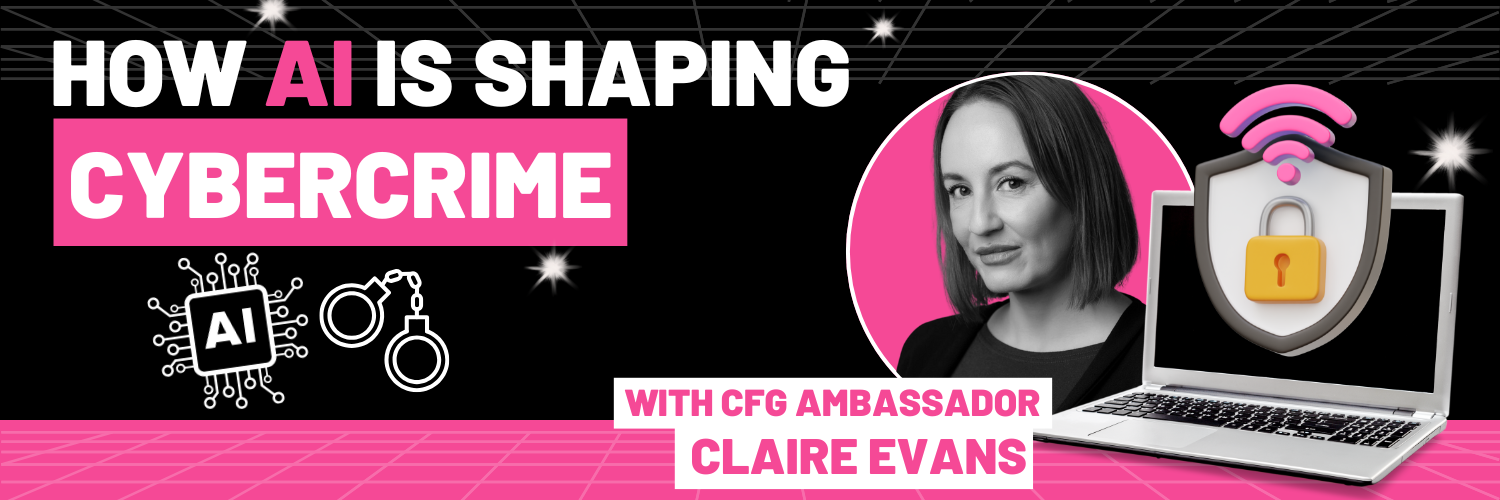
Content Menu
How AI is shaping Cybercrime
Hi! I’m Claire Evans, a CFG Ambassador and Data Technician at iProov, working with facial biometric technology to secure digital identities, which means naturally I have a keen interest in Cybersecurity and how it’s rapidly evolving, thanks to artificial intelligence (AI).
While AI significantly boosts our defences, it also equips cybercriminals with powerful new tools, which means understanding AI’s dual role is crucial, especially for individuals (like you!) exploring a career in tech.
In this blog post, I’ll dive into how AI is reshaping cybercrime, exploring the good and bad, and what the future might hold.
Types of Cybercrime
Cybercrime involves criminal activities carried out online, targeting computers, networks, or digital identities, and often includes offences such as identity theft, phishing, ransomware attacks, financial fraud, and unauthorised access to sensitive information.
Cybercriminals can operate individually or as part of organised groups, and their motives can range from financial gain and political agendas to personal revenge or social disruption. Some cybercrimes are carried out to exploit vulnerabilities in software, while others use social engineering tactics to trick users into revealing confidential information.
As digital technology continues to evolve, cybercrime is becoming more sophisticated and harder to detect, posing serious threats to individuals, businesses, and even governments. Addressing it requires advanced cybersecurity measures, international cooperation, and increased awareness among users about safe online behaviour.
There are many different forms of cybercrime, but the most common types of cybercrime include:
- Phishing: Fraudulent communications to steal personal information.
- Malware: Harmful software like ransomware or viruses.
- Identity Theft: Stealing personal details for fraud.
Cybercrime affects businesses and individuals alike — 32% of UK businesses experienced cyber incidents in 2023 and AI is now central to both committing and defending against these crimes.
Using AI in Cybercrime
The rise of AI has given us many benefits in today’s world, with one of those being the ability to defend against cyber-attacks effectively and efficiently. From threat hunting to automated incident responses, AI has opened up new ways for organisations and individuals to be more protected against malicious activity.
Here’s a quick look at just some of the ways that AI gives cybersecurity teams powerful tools to detect and respond to threats swiftly and effectively:
- Threat Detection: AI spots unusual activities instantly, reducing human response delays.
- Phishing Protection: Email providers use AI to identify malicious messages, blocking over 99% of threats automatically.
- Facial Biometrics: At iProov, we use AI-driven facial recognition with advanced liveness detection, ensuring digital identities are authentic and not deepfakes. Globally, 75% of organisations are adopting facial biometrics to counter AI-powered identity fraud.
In my experience, working with AI in biometrics is exciting because it allows us to always be a step ahead of fraudsters, continuously improving our defences to protect identities securely.
Unfortunately, with the good also comes the bad. Cyber criminals are quick to misuse AI technology to their own advantage, resulting in more sophisticated and targeted attacks.
AI is allowing cyber criminals to be smarter and faster, resulting in more convincing attacks. Here’s just a few of the ways they’re doing that:
- Deepfake Technology: Cybercriminals use AI-generated video and audio, known as deepfakes, to impersonate individuals convincingly. Deepfake scams surged by 400% in the UK since 2017 (UK Gov, 2025). The UK recently introduced laws criminalising explicit non-consensual deepfake content.
- AI-Enhanced Phishing: AI chatbots now craft believable phishing emails, dramatically increasing attacks. Since AI tools like ChatGPT emerged, phishing attacks rose by 1,265%.
- Automated Malware: Tools like WormGPT provide criminals with AI-generated malware, enabling those without extensive coding skills to launch sophisticated attacks quickly.
As I often say at iProov, “Facial biometric technologies must constantly evolve because deepfake threats grow smarter every day. Staying ahead is essential.”
The future of AI in Cybercrime
AI-driven cyber threats will only escalate, but so will our defences. These are the key trends shaping the future of cybersecurity:
- AI-Powered Attacks: Attacks will increasingly use AI to target vulnerabilities rapidly and precisely.
- AI Defence Systems: We’ll see defensive AI becoming standard, automatically countering threats in real-time.
- Advanced Biometrics: Facial biometrics and deepfake detection will advance significantly, employing sophisticated methods like heartbeat detection and dynamic response challenges.
- Ethical and Legal Frameworks: There’s a growing emphasis on ethical AI and tighter regulations. The UK’s new laws criminalising deepfakes demonstrate this shift.
A diverse, ethical approach is crucial. Cybersecurity needs innovative minds who prioritise responsible AI use. My role in facial biometrics continually reminds me of the importance of ethical innovation in tech.
There’s a growing emphasis on ethical AI and tighter regulations. The UK's new laws criminalising deepfakes demonstrate this shift.
Conclusion
As we’ve seen, AI is transforming the cybersecurity landscape on both sides of the battle. It’s enabling defenders to move faster, smarter, and more proactively, but it’s also giving cybercriminals unprecedented power to launch complex, targeted attacks with alarming ease.
For anyone stepping into the tech world, especially in cybersecurity, understanding this dual role of AI isn’t just useful, it’s essential!
Cybersecurity is no longer just about firewalls and passwords—it’s about innovation, responsibility, and constant evolution. And with AI now at the heart of it all, the industry needs curious, forward-thinking minds more than ever. If that sounds like you, there’s never been a more exciting time to get involved.
Ready to make an impact? If you’re inspired to join the fight against cyber threats, check out how you can start your career in Cyber Security here – your career in cyber security awaits!


















